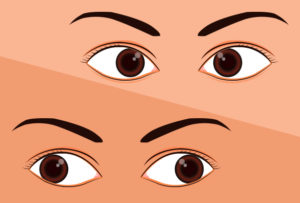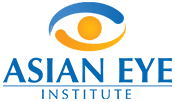Pediatric Ophthalmology and Optometry, Orthoptics and Strabismus
Like adults, infants and children can also suffer from eye problems. They rarely complain about what they are experiencing, assuming that whatever vision they have is normal. However, having poor vision can impede their learning and development, and even affect the way they interact with other children.
Types of Eye Problems in Children
The most common eye problems that may affect children include:
REFRACTIVE ERRORS

The most common type of vision problem, these are caused by the inability to focus images on the retina (the back part of the eye), making it hard for children to see clearly. These can be caused by three (3) things – changes in the length of the eyeball, changes in the shape of the cornea (the clear surface layer of the eye), and aging of the lens.
Children may experience any of these types of refractive errors:
- Myopia – More commonly known as nearsightedness, this happens when the eyeball is slightly longer than normal or the refractive power of the eye is too strong. Because of this, children can see nearby objects clearly but things afar look blurry. It also often progresses as children grow older.
- Hyperopia – Babies are naturally farsighted. However, they see clearly at near because they have strong “autofocusing” abilities (accommodation), which allows them to overcome farsightedness.
- Astigmatism – This vision problem happens when the normally smooth cornea (clear surface layer of the eye) is curved or becomes oblong. This makes your child’s vision blurry, whether it is near, far or intermediate. Astigmatism may start in childhood and may happen in combination with nearsightedness or farsightedness.
Symptoms
Anyone can have refractive errors, but your child’s risk increases if one or both parents have any of the three (3) types. When it comes to signs and symptoms, it is important for parents to be observant of their children. Among the things that parents need to look out for are:
- frequent headaches
- frequent eye rubbing
- holding objects close to the eyes
- sitting too close to the TV
- squinting
- avoiding to read or do other close activities
- turning head to the side misaligned eyes
Treatment
Eyeglasses or contact lenses are often prescribed refractive errors. This allows children to have the clear vision they need for their learning and development. However, the device or eyewear they will use depends on their age, type of refractive error or needs.
Does wearing eyeglasses or contact lenses make your eyes or vision worse? Does it cause your child’s eye grade to increase? It does not. Your child’s eye grade may increase as they grow older, especially if nearsighted. All nearsighted children experience an increase in their eye grade. It is also not true that wearing eyeglasses or contact lenses will make them dependent on them. They are just getting used to seeing things more clearly, so they want to wear it more often.
At present, there are myopia control lenses and Ortho-K contact lenses. These are specially designed eyewear to slow the progression of nearsightedness in children. This is especially helpful as having high nearsightedness can lead to potentially blinding eye diseases, such as retinal detachment and glaucoma.
When they turn 18 and their eye grade has become stable, they may undergo LASIK screening to see if they are qualified for LASIK surgery. LASIK surgery [to link to LASIK service page] is a popular procedure that lets patients enjoy clear vision, without having to wear eyeglasses or contact lenses.
AMBLYOPIA

Amblyopia or lazy eye is a condition where there is reduced vision in one or both eyes. Normally, the brain uses both eyes to see. If both eyes have poor vision (ie. refractive error), the vision center of the brain will not develop properly resulting in “lazy eyes”. One eye has poor vision, the brain will prefer the better eye and will ignore the weaker eye. When that happens, the weaker or “lazy” eye often wanders inward or outward. Lazy eye develops in childhood, usually when only one eye is used from birth until the child is 7 years old.
Symptoms
Some children are born with lazy eyes, but others may develop it if they have misaligned eyes (one eye turns in or out); a difference in the prescription of each eye; or an eye problem that obstructs vision in either eye (cataract, droopy eyelid). Lazy eye rarely affects both eyes, and you may also notice the following signs or symptoms:
- wandering eye
- eyes that seem to not work together
- squinting or shutting one eye
- tilting head to one side
Treatment
It is important to start the treatment for lazy eyes during childhood. It is during this critical time that complicated connections between the eye and the brain are forming. Treatment options will depend on the cause of the lazy eyes:
- patching – Sticky eye patches are worn on the better eye for two to six or more hours a day. This forces the brain to use the weaker eye to see, and helps this eye to be stronger.
- prescription eyewear – Full-time wear of eyeglasses or contact lenses can help correct refractive errors (nearsightedness, farsightedness or astigmatism) that result in lazy eye
- eye drops – Atropine eye drop is used to temporarily blur the better eye, which forces the brain to use the weaker eye.
- Bangerter filter – A special filter, it is placed on the eyeglass lenses and functions like an eye patch. The filter blurs the stronger eye to stimulate the weaker eye.
- Surgery – Children with cataracts or droopy eyelids might have to undergo surgery to remove what is blocking their vision. If your child has misaligned eyes, his/her doctor may recommend a surgical repair to improve the appearance of the eyes.
- Orthoptic exercises – The child will have to do certain activities like coloring, word games, Lego building while his/her better eye has a patch. Once the weaker eye has improved, the child may do other exercises like pencil push-ups.
STRABISMUS

Strabismus is a condition in which there is a misalignment of the eyes. This happens when both eyes are not working together when looking at an object. One eye may look straight ahead, while the other may turn inward (cross-eyed), outward (wall-eyed), upward (hypertropia) or downward (hypotropia). It may be permanent or intermittent.
Cause
Each eye has six (6) muscles that control its movements and alignment. These muscles are attached to the outside of the eye and are controlled by the brain. All these have to work and move together. If one or two muscles do not move well, strabismus happens. It can also happen, especially if he/she has:
- family history of strabismus – If a parent has strabismus, their child is likely to develop it.
- uncorrected refractive error – A child with a significant amount of uncorrected refractive error (nearsightedness, farsightedness or astigmatism) may develop this condition.
- medical condition – Risk for strabismus increases if a person is suffering from conditions like Down Syndrome, cerebral palsy, have suffered from stroke, brain tumor or head injury
Types of Strabismus
Strabismus can also develop in both children and adults. There are several types of strabismus, and the two most common forms are:
- Accommodative esotropia – occurs due to uncorrected farsightedness. A patient that is farsighted has to focus hard to see images clearly up close. This focusing effort is referred to as accommodation. The closer the object is, the more accommodation is needed, and this may cause crossed eyes. It typically starts in the first few years of life, and may cause double vision, squinting or covering one eye when looking at an object nearby or tilting the head to the side.
- Intermittent exotropia – occurs when the eyes cannot coordinate together. One eye may look straight at an object, while the other may look outward, or both eyes may turn outward. It can start at any age, and often causes headaches, eyestrain or difficulty reading. Some people do not experience any signs or symptoms.
Treatment
The earlier the strabismus is detected and managed, the higher the success rate of the treatments are likely to be. If not treated immediately, the patient may experience double vision, have problems with 3D vision or depth perception, or develop lazy eyes. There are different ways to treat or manage strabismus, depending on the cause and extent of the condition:
- prescription eyewear – if the person has an uncorrected refractive error, they may be prescribed with eyeglasses or contact lenses to correct their vision.
- prism lenses – these are special lenses that are thicker on one side than the other. The goal is to bend the light that enters the eye to reduce the amount of turning the eye when looking at objects.
- orthoptic exercises – structured visual activities will be prescribed to help problems with movement, focusing, teaming of the eyes. These will help improve the eye by training the eyes and the brain to work together more effectively.
eye muscle surgery – to make the eyes appear straight or aligned, eye muscle surgery is done to change the position or length of the muscles around the eyes. However, this is usually combined with orthoptic exercises to prevent the eyes from getting misaligned again.
Infants and children may also develop serious eye conditions:
- Pediatric cataract – clouding of the normally clear lens of the eye, causing blurry vision. If left untreated, it can lead to blindness.
- Retinoblastoma – a rare form of eye cancer, retinoblastoma usually occurs in children younger than 5 years old and may be in one eye or both eyes.
- Retinopathy of prematurity (ROP) – a potentially blinding eye disease that usually affects premature babies. It is the development of abnormal blood vessels in the retina of the eye. These vessels are fragile, causing it to leak. Eventually, it will pull the retina from the inner surface of the retina, leading to retinal detachment.
Children are more responsive to treatment when diagnosed early. That is why comprehensive eye exams are important. It is best for infants to get their vision screen as soon as they are born. Formal vision tests can begin as early as 3 years old or before going to school. More frequent comprehensive eye exams are required for those who were born prematurely, have developmental delays or are cross-eyed.







